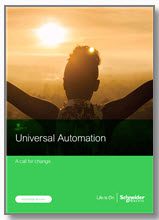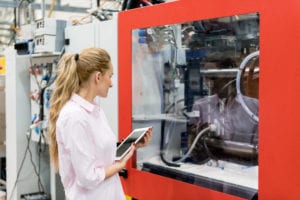 A call for change
A call for change
We are now living in a true digital economy. Technological innovations and the internet have forever changed how the business of the world gets done. At the same time, the recent pandemic and resulting global economic disruption has served as a “wake up call” for industrial enterprises to no longer postpone much-needed operational advancements in automation and digitalization. Even established companies that were once perceived to be immune from market fluctuations are finding themselves challenged by unprecedented global dynamics and by newcomers who are embracing digital technologies to create agile businesses that better serve the modern world.
No one company can navigate these conditions alone. Persisting in this new world requires an extended ecosystem of partners collaborating to succeed. At Schneider Electric, we believe the time is right for a bold move in industrial automation. We’re calling it universal automation and it will forever change the way we automate operations.
Universal automation
Universal automation is the world of plug-and-produce automation software components (think app store) enabled by the IEC 61499 standard. At Schneider Electric:
- We believe “open automation” as it exists today is not open enough.
- We believe interoperable and portable application software is an essential enabler for next-generation industries.
- We believe broad adoption of universal automation will unleash a wave of unbounded innovation and usher in a new era of à la carte automation where cost/performance is optimized by integrating best-of-breed components without regard to vendor.
- We believe industrial enterprises will embrace this ever-growing automation app marketplace to realize step-change improvements in efficiency and sustainability we could only dream of a decade ago.
This is NOT business as usual.
Next-generation industrial automation
Little has changed in the fundamentals of how industrial automation systems have been designed, implemented and operated over the past 50 years. Current industrial automation system architecture has done a good job of advancing industry to where we are today, but to fully realize the promise of the Fourth Industrial Revolution, we need to fundamentally change our technology model.
Propriety systems make it difficult for businesses to address digital age challenges and limit digital innovation because:
- Automation applications written for one system will not easily run on another. This makes it costly and difficult for industrial organizations to innovate, causing slow changes and limiting the ability to integrate revolutionary approaches.
- Lack of reference implementation for standards creates architectural challenges that lead to isolated islands of control and inefficiencies.
- Proprietary systems are not designed to take advantage of the recent and rapid changes in IT.
- Custom-programmed and proprietary systems are expensive to maintain and difficult to upgrade.
IEC 61499
In a previous blog, I identified the IEC 61499 standard as a high-level system design language for distributed information and control systems. IEC 61499 is the technical foundation for universal automation because it:
- Enables automation applications to be built using portable, proven-in-use software components, independent of the underlying automation hardware.
- Allows the user to distribute the application to any system hardware architecture of choice—highly distributed, centralized, or both—all with little programming effort.
- Supports mainstream software best practices making it easy to create automation applications that interoperate with IT systems. Native IT convergence and easy portability will drive a long-term shift from low-value programming of proprietary controllers to high-value plug-and produce automation systems using proven-in-use automation software components.
The future of automation is wide open
We can create operational improvements with an open, standard-based architecture and a plug-and-produce application ecosystem. Universal automation will allow OEM’s, integrators, and end-users to build automation solutions by plugging together best-of-breed apps using low-code graphical tools. Proven-in use software components will make the system more reliable, and more easily expanded and adapted for future needs.
This new Universal automation world, with IEC61499-enabled digitization at its center, will surpass business-as-usual on multiple levels:
- Software plays a leading role
- Step change improvements are made in efficiency, agility, and sustainability
- Next-generation automation workforce is empowered to use control for improving business outcome, most notably profitability
- IT/OT convergence is strengthened
Will you be part of the universal automation future?
 To discover more about how universal automation will forever change the way we automate operations, download the Schneider Electric white paper “Universal Automation: A call for change”
To discover more about how universal automation will forever change the way we automate operations, download the Schneider Electric white paper “Universal Automation: A call for change”



